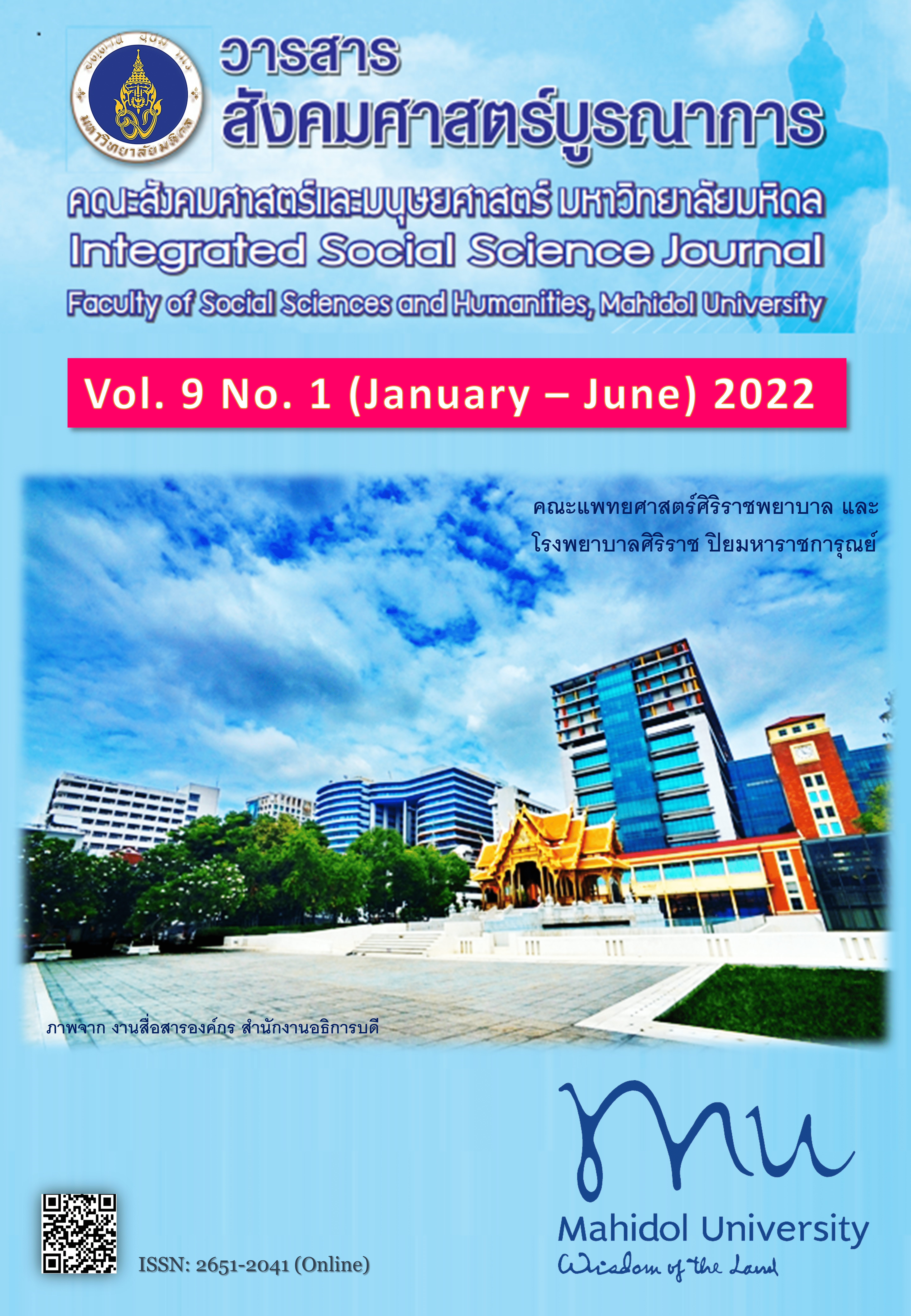กลยุทธ์เพื่อลดภาวะถดถอยทางการเรียนรู้ของนักเรียนไทย จากการเรียนการสอนออนไลน์ ในสถานการณ์การแพร่ระบาดของเชื้อไวรัสโควิด-19
Main Article Content
บทคัดย่อ
บทความนี้มีวัตถุประสงค์เพื่อให้ข้อเสนอแนะเพื่อการปรับปรุงรูปแบบการจัดการเรียนการสอนของเด็กนักเรียนไทยในระดับการศึกษาขั้นพื้นฐาน เพื่อลดผลกระทบที่เกิดขึ้นของการเรียนการสอนแบบออนไลน์ในช่วงสถานการณ์การแพร่ระบาดของเชื้อไวรัสโควิด-19 ผลจาการค้นคว้าเอกสารหลักฐานและใช้การวิเคราะห์เนื้อหา เพื่อนำไปสู่ข้อค้นพบเชิงอุปนัย พบว่า การเรียนการสอนออนไลน์ส่งผลต่อพัฒนาการด้านการศึกษาของนักเรียน ไม่เพียงแต่ส่งผลกระทบทางลบในระยะสั้นเท่านั้น เช่น การสร้างความกังวล ความเครียด ความแปลกแยกโดดเดี่ยว ภาวะซึมเศร้า มีความคิดและความพยายามฆ่าตัวตาย หรือแม้แต่มีผลสัมฤทธิ์ทางการศึกษาที่ลดลง แต่ยังส่งผลกระทบระยะยาวต่อพัฒนาการด้านทักษะต่าง ๆ ของนักเรียนในช่วงต่อไปของชีวิตอีกด้วย อีกทั้ง ยังเป็นการขยายช่องว่างความเหลื่อมล้ำทางการศึกษา (educational inequalities) ระหว่างเด็กที่มีสถานะทางเศรษฐกิจและสังคมที่ต่างกันให้มากยิ่งขึ้น เพื่อลดภาวะถดถอยทางการเรียนรู้ของนักเรียนในระดับการศึกษาขั้นพื้นฐานจากการเรียนการสอนออนไลน์ในช่วงสถานการณ์การแพร่ระบาดของเชื้อไวรัสโควิด-19 ผู้เขียนได้เสนอให้ใช้กระบวนการหล่อหลอมทางสังคมในครอบครัว (family socialization) การเรียนรู้อย่างกระตือรือร้น (active learning) การสร้างความเป็นพลเมืองที่ตื่นรู้ของนักเรียนและผู้ปกครอง (active citizenship) รวมถึงการร่วมกันสร้างสรรค์นวัตกรรมการสอนและการเรียนรู้ (co–creation of teaching and learning) เพื่อลดภาวะถดถอยทางการเรียนรู้ของนักเรียนในสถานการณ์การแพร่ระบาดของเชื้อไวรัสโควิด-19
Article Details

อนุญาตภายใต้เงื่อนไข Creative Commons Attribution-NonCommercial-NoDerivatives 4.0 International License.
- วารสารสังคมศาสตร์บูรณาการ มหาวิทยาลัยมหิดล อนุญาตให้สามารถนำไฟล์บทความไปใช้ประโยชน์และเผยแพร่ต่อได้ โดยอยู่ภายใต้เงื่อนไขสัญญาอนุญาต CC Attribution-NonCommercial-NoDerivatives 4.0 International (CC BY-NC-ND 4.0) โดยต้องแสดงที่มา/การอ้างอิงจากวารสาร – ไม่ใช้เพื่อการค้า – ห้ามแก้ไขดัดแปลงเนื้อหา
- ข้อความที่ปรากฏในบทความในวารสารฯ เป็นความคิดเห็นส่วนตัวของผู้เขียนแต่ละท่าน ไม่เกี่ยวข้องกับกองบรรณาธิการวารสารฯ (ซึ่งหมายรวมถึง บรรณาธิการ ผู้ทรงคุณวุฒิในกองบรรณาธิการ หรือ บรรณาธิการรับเชิญ) แต่อย่างใด ความรับผิดชอบองค์ประกอบทั้งหมดของบทความแต่ละเรื่องเป็นของผู้เขียนแต่ละท่าน หากมีความผิดพลาดใด ๆ ผู้เขียนแต่ละท่านจะรับผิดชอบบทความของตนเอง ตลอดจนความรับผิดชอบด้านเนื้อหาและการตรวจร่างบทความเป็นของผู้เขียน ไม่เกี่ยวข้องกับกองบรรณาธิการวารสารฯ
- กองบรรณาธิการขอสงวนสิทธิ์ในการตัดทอน/ปรับแก้ถ้อยคำบางประการเพื่อความเหมาะสม
เอกสารอ้างอิง
กรมคุ้มครองสิทธิและเสรีภาพ กระทรวงยุติธรรม. (2565). (ร่าง) แผนสิทธิมนุษยชนแห่งชาติ ฉบับที่ 5 ด้วยกระบวนการมีส่วนร่วมของทุกภาคส่วน. [เอกสารไม่ได้ตีพิมพ์]
งานโรคติดต่ออุบัติใหม่ กลุ่มพัฒนาวิชาการโรคติดต่อ. (2564). สถานการณ์โรคติดเชื้อไวรัสโคโรนา 2019 (COVID-19) มาตรการสาธารณสุข และปัญหาอุปสรรคการป้องกันควบคุมโรคในผู้เดินทาง. https://ddc.moph.go.th/uploads/files/2017420210820025238.pdf
ญาศินี เกิดผลเสริฐ. (2558). การพัฒนาทุนมนุษย์สู่ความเป็นพลเมืองที่ตื่นตัว. วารสารบริหารการศึกษา มหาวิทยาลัยศิลปากร, 15(2), 166-175.
ทินลัคน์ บัวทอง, สังวรณ์ งัดกระโทก และ นลินี ณ นคร. (2563). การประเมินผลกระทบของความเหลื่อมล้ำด้านทรัพยากรทางการศึกษาต่อผลสัมฤทธิ์ทางการเรียนของนักเรียนประถมศึกษาตอนต้นในจังหวัดตาก. วารสารวิจัยราชภัฏพระนคร สาขามนุษยศาสตร์และสังคมศาสตร์, 15(1), 168-184.
ธรรมรัตน์ แซ่ตัน, โภไคย เฮ่าบุญ, โสภณ จันทร์ทิพย์, ธงชัย สุธีรศักดิ์ และวัชรวดี ลิ่มสกุล. (2564). ความพร้อมต่อการเรียนการสอนแบบออนไลน์ของนักศึกษาภายใต้สถานการณ์การระบาดไวรัส COVID-19: กรณีศึกษา มหาวิทยาลัยสงขลานครินทร์ วิทยาเขตภูเก็ต. วารสารสังคมวิจัยและพัฒนา, 3(1), 23-37.
วิชัย วงษ์ใหญ่ และ มารุต พัฒผล. (2563). การเรียนรู้ร่วมกันสร้างสรรค์นวัตกรรม Co-Creation Learning. บัณฑิตวิทยาลัย มหาวิทยาลัยศรีนครินทรวิโรฒ.
สำนักงานเลขาธิการสภาการศึกษา กระทรวงศึกษาธิการ. (2564). รายงานผลการศึกษาภาวะถดถอยทางการเรียนรู้ของผู้เรียนระดับการศึกษาขั้นพื้นฐานในสถานการณ์โควิด-19: สภาพการณ์ บทเรียน และแนวทางการพัฒนาคุณภาพการเรียนรู้. http://www.onec.go.th/th.php/book/BookView/1932
อรรณพ เยื้องไธสง, ศุภวงค์ โหมวานิช, รัชนก อุ้ยเฉ้ง, และ อุบลวรรณ หงษ์วิทยากร. (2565). ความเหลื่อมล้ำทางการศึกษา: สภาพการจัดการเรียนรู้ออนไลน์ในช่วงการแพร่ระบาดของเชื้อไวรัส COVID-19. วารสารสังคมวิจัยและพัฒนา,4(2), 13–29.
Alban Conto, C., Akseer, S., Dreesen, T., Kamei, A., Mizunoya, S., & Rigole, A. (2021). Potential effects of COVID-19 school closures on foundational skills and Country responses for mitigating learning loss. International Journal of Educational Development, 87, 102434. https://doi.org/10.1016/j.ijedudev.2021.102434
Betebenner, D. & Van Iwaarden, A. (2020). Issues and considerations that the COVID‐19 pandemic presents for measuring student growth [Blog post]. https://www.nciea.org/blog/sgp/issues-and-considerations-covid-19-pandemic-presents-measuring-student-growth
Bovill, C. (2020). Co-creation in learning and teaching: The case for a whole-class approach in higher education. Higher Education, 79(6), 1023–1037.
Bugental, D. B., & Goodnow, J. J. (1998). Socialization processes. In Handbook of child psychology: Social, emotional, and personality development, Vol. 3, 5th ed (pp. 389–462). John Wiley & Sons, Inc.
Cohodes, E. M., McCauley, S., & Gee, D. G. (2021). Parental buffering of stress in the time of COVID-19: Family-level factors may moderate the association between pandemic-related stress and youth symptomatology. Research on Child and Adolescent Psychopathology, 49(7), 935–948.
Froese I. (2020). Lack of computers, internet access exposes shortfall of at-home learning in Manitoba. CBC News Manitoba [online]: cbc.ca/news/canada/manitoba/lack-computers-internet-shortfall-at-home-learning-manitoba-winnipeg-1.5531100.
Giannopoulou, I., Efstathiou, V., Triantafyllou, G., Korkoliakou, P., & Douzenis, A. (2021). Adding stress to the stressed: Senior high school students’ mental health amidst the COVID-19 nationwide lockdown in Greece. Psychiatry Research, 295, 113560. https://doi.org/10.1016/j.psychres.2020.113560
Hollander, E. P. (1976). Principles and methods of social psychology. Oxford University Press.
Hou, T., Mao, X., Dong, W., Cai, W., & Deng, G. (2020). Prevalence of and factors associated with mental health problems and suicidality among senior high school students in rural China during the COVID-19 outbreak. Asian Journal of Psychiatry, 54, 102305. https://doi.org/10.1016/j.ajp.2020.102305
Michael, J. (2006). Where’s the evidence that active learning works? Advances in Physiology Education, 30(4), 159–167.
Middleton, K. V. (2020). The longer‐term impact of covid‐19 on k–12 student learning and assessment. Educational Measurement: Issues and Practice, 39(3), 41–44.
Parte, L., & Herrador-Alcaide, T. (2021). Teaching disruption by COVID-19: Burnout, isolation, and sense of belonging in accounting tutors in e-learning and b-learning. International Journal of Environmental Research and Public Health, 18(19), 10339.
Pereda, N., & Díaz-Faes, D. A. (2020). Family violence against children in the wake of COVID-19 pandemic: A review of current perspectives and risk factors. Child and Adolescent Psychiatry and Mental Health, 14(1), 40. https://doi.org/10.1186/s13034-020-00347-1
Plakhotnik, M. S., Volkova, N. V., Jiang, C., Yahiaoui, D., Pheiffer, G., McKay, K., Newman, S., & Reißig-Thust, S. (2021). The perceived impact of COVID-19 on student well-being and the mediating role of the university support: Evidence from France, Germany, Russia, and the UK. Frontiers in Psychology, 12, 642689. https://doi.org/10.3389/fpsyg.2021.642689
Radu, M.-C., Schnakovszky, C., Herghelegiu, E., Ciubotariu, V.-A., & Cristea, I. (2020). The impact of the covid-19 pandemic on the quality of educational process: A student survey. International Journal of Environmental Research and Public Health, 17(21), 7770. https://doi.org/10.3390/ijerph17217770
Rao, M. E., & Rao, D. M. (2021). The mental health of high school students during the COVID-19 pandemic. Frontiers in Education, 6, 719539. https://doi.org/10.3389/feduc.2021.719539
Spitzer, M. W. H., & Musslick, S. (2021). Academic performance of K-12 students in an online-learning environment for mathematics increased during the shutdown of schools in wake of the COVID-19 pandemic. PLOS ONE, 16(8), e0255629. https://doi.org/10.1371/journal.pone.0255629
The Lancet Child & Adolescent Health. (2020). Pandemic school closures: Risks and opportunities. The Lancet Child & Adolescent Health, 4(5), 341.
Whitley, J., Beauchamp, M. H., & Brown, C. (2021). The impact of COVID-19 on the learning and achievement of vulnerable Canadian children and youth. FACETS, 6, 1693–1713.


